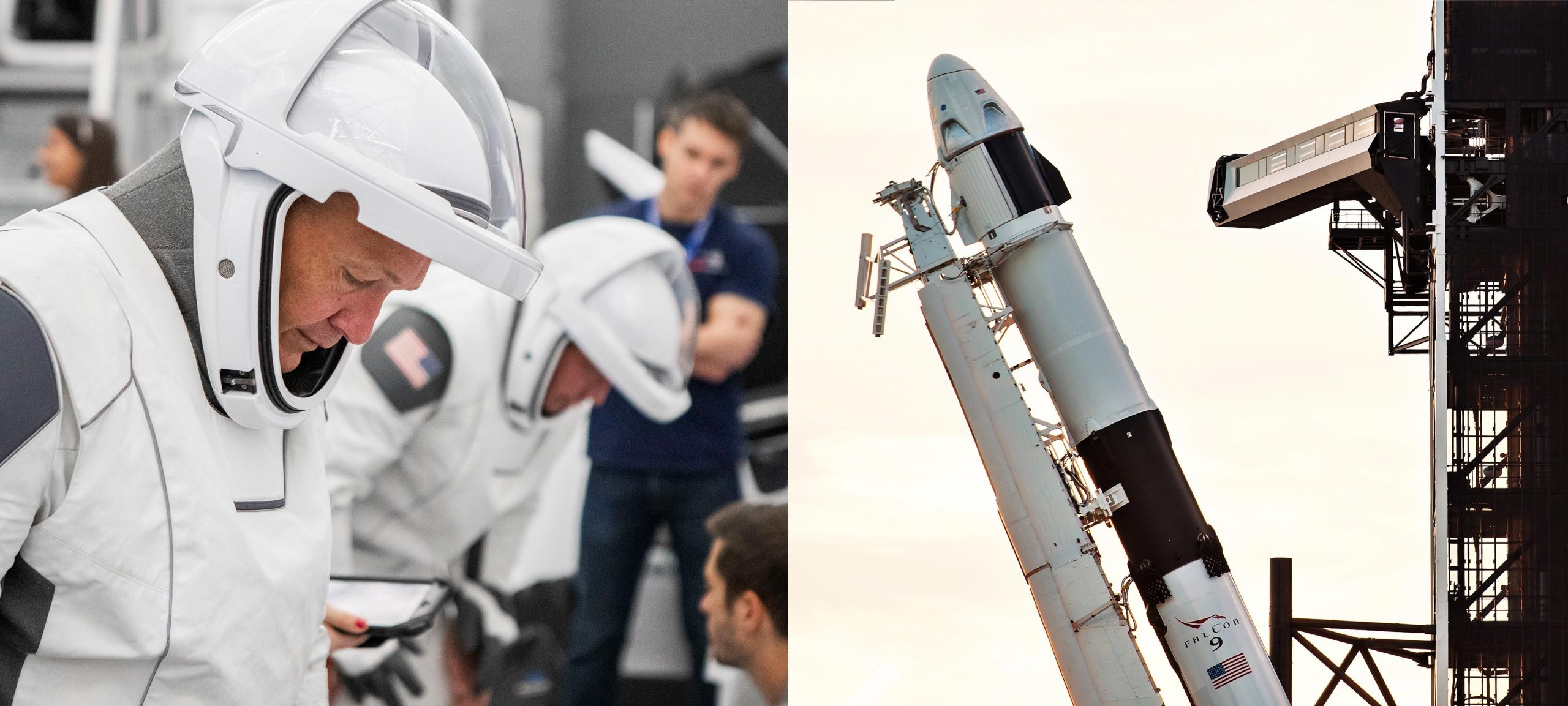
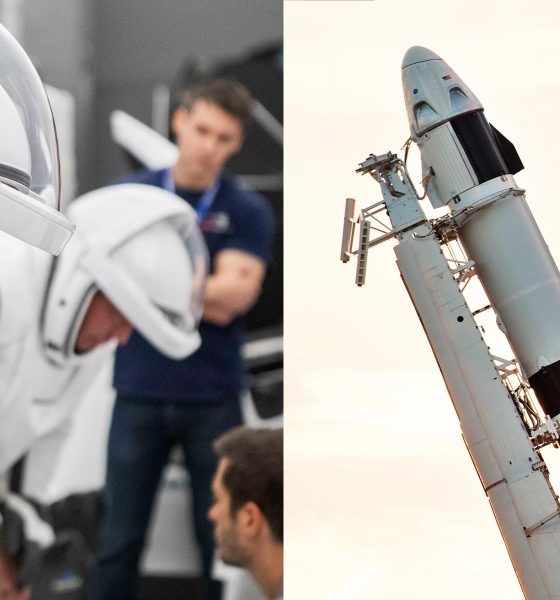
News
SpaceX’s first Crew Dragon NASA astronauts suit up for spacesuit-focused launch rehearsal
While a great deal of work remains before SpaceX and NASA are ready to set a date for Crew Dragon’s inaugural astronaut launch (Demo-2) both teams continue to actively prepare for the milestone mission.
Most recently, NASA has published photos detailing a critical (and literal) dress rehearsal with astronauts Col. Bob Behnken and Col. Doug Hurley, set to become the first astronauts to ride SpaceX’s Crew Dragon to orbit and dock with the International Space Station (ISS). This particular test centered around the process of suiting up in SpaceX’s iconic, custom-built spacesuits and simulated pre-launch procedures in a Crew Dragon simulator located at SpaceX’s Hawthorne, CA headquarters.
A literal dress rehearsal
On Thursday, an official NASA Astronaut account tweeted that SpaceX’s first two Commercial Crew astronauts had recently completed a dress rehearsal test of the spacesuits that they will wear during Crew Dragon’s inaugural crewed launch to the ISS. Bob Behnken and Doug Hurley participated in a full “suit-up & leak checks” rehearsal with their iconic SpaceX-built suits and the same Ground Support Equipment (GSE) hardware that will be used during Demo-2. This dress rehearsal also serves to familiarize the SpaceX and NASA ground support crew with the astronaut suit-up process, and multiple technicians and flight engineers are visible in the background.
The new spacesuits made their press debut last summer at a media event held at SpaceX headquarters in Hawthorne, California. Not only are they uniquely beautiful and modernist, but SpaceX’s spacesuits are also designed first and foremost with functionality in mind. SpaceX hired its own team of seamstresses and focused heavily on integrating 3D printing into suit production, resulting in an end-product that is simultaneously strikingly minimalistic and extremely usable. For example, the helmets Behnken and Hurley are seen wearing use 3D printing to integrate extremely complex life support systems, a built-in microphone and speaker communications array, a seamless multi-hinged visor, and more.

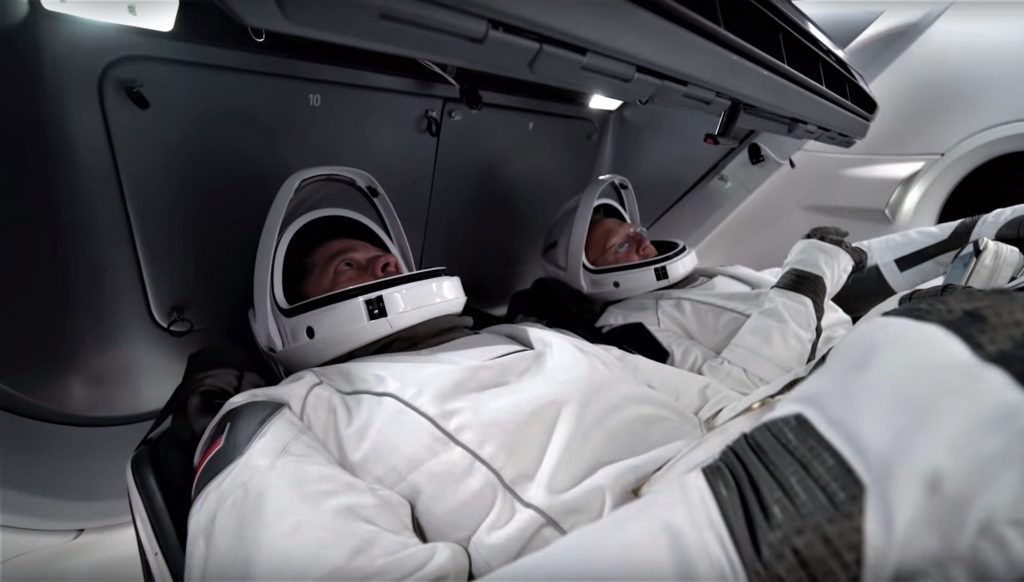
The suits are also designed to allow for easy maneuverability and a seamless user experience within the Dragon capsule. The attached gloves of the suit use conductive leather to allow the astronauts to interact with the Crew Dragon’s primary controls, a set of large touchscreens. Apple iPads will additionally be mounted directly on the thighs of the astronauts to serve as an even more convenient (and redundant) method of interfacing with Dragon’s controls, among other things.
While the suits are designed to be pressurized to support the astronauts in the event of a life-threatening event that may occur aboard Dragon, they are not meant for spacewalks or prolonged exposure to the vacuum of space.
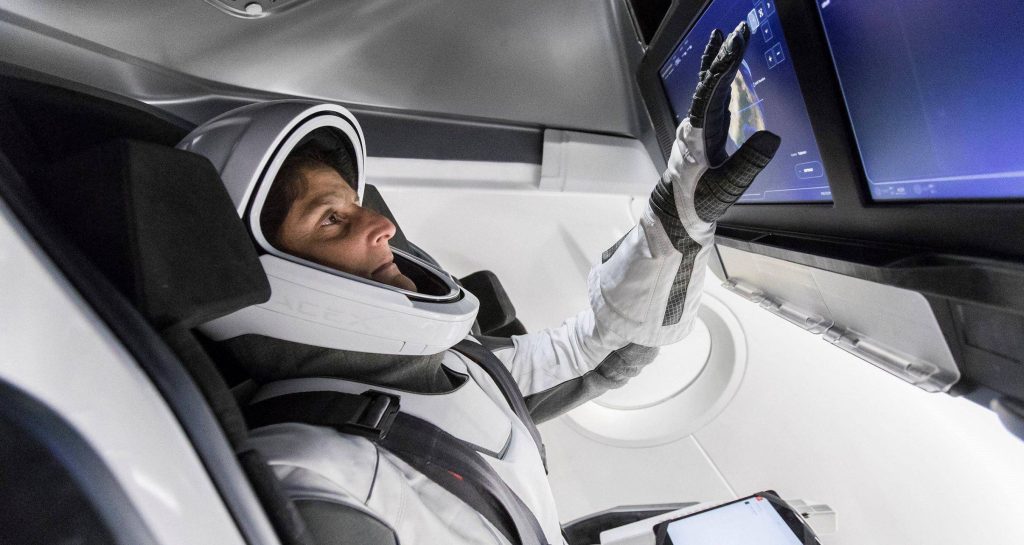
Behnken, Hurley, and other Commercial Crew astronauts have been included in the development of their suits since day one and each flight suit has been carefully tailored to fit each future Crew Dragon astronaut. Having the opportunity to run through a launch day dress rehearsal allows everyone in the process to become familiarized with the specialized procedures that will occur ahead of boarding the Dragon capsule.
Crew Dragon sidesteps the norm
Unlike previous crewed NASA launches, SpaceX plans to have astronauts board Crew Dragon before launch vehicle fueling begins. This new approach to crew loading has become known as “Load-and-Go.” This procedure is extremely familiar to SpaceX, as the company supercools the liquid oxygen and kerosene propellant used by Falcon 9 and Heavy to significantly improve the performance of both rockets.
SpaceX has made the rational argument that boarding astronauts before fueling is actually significantly safer than the traditional method of ingressing astronauts while the rocket is fully fueled. Once inside Crew Dragon, the spacecraft’s SuperDraco abort system would be armed, theoretically protecting its astronauts from any conceivable explosion-related vehicle failure, whereas a fueled rocket failing during ingress could easily kill anyone in close proximity for the boarding procedure.
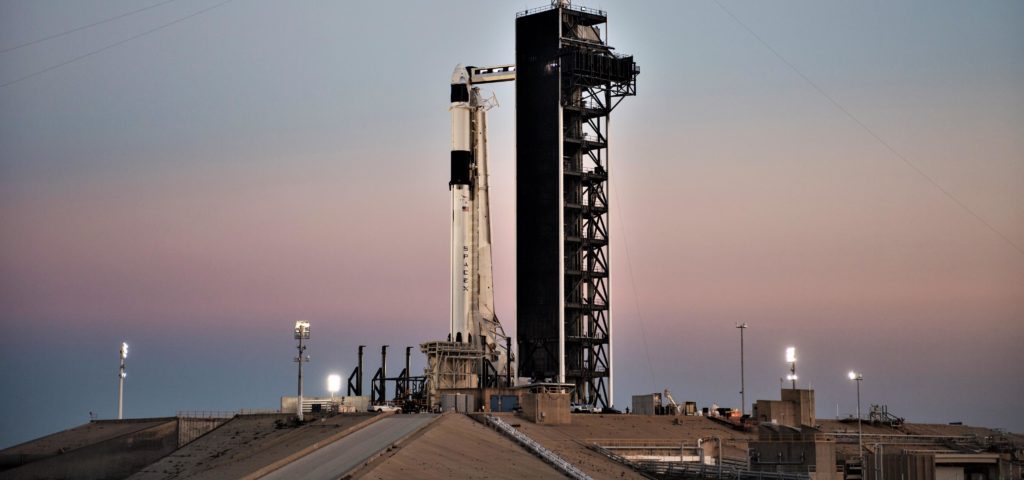
According to NASA, possible dates for Crew Dragon’s Demo-2 astronaut launch debut are under review. In a mid-July conference call with SpaceX and NASA officials, neither were particularly confident that Demo-2 would be ready to launch before the end of 2019, although they specifically did not rule the possibility out. More likely than not, Crew Dragon Demo-2 will slip into early 2020 as a result of a catastrophic explosion that destroyed Crew Dragon capsule C201 during static fire testing earlier this year.
Check out Teslarati’s Marketplace! We offer Tesla accessories, including for the Tesla Cybertruck and Tesla Model 3.

News
Tesla FSD fleet is nearing 7 billion total miles, including 2.5 billion city miles
As can be seen on Tesla’s official FSD webpage, vehicles equipped with the system have now navigated over 6.99 billion miles.

Tesla’s Full Self-Driving (Supervised) fleet is closing in on almost 7 billion total miles driven, as per data posted by the company on its official FSD webpage.
These figures hint at the massive scale of data fueling Tesla’s rapid FSD improvements, which have been quite notable as of late.
FSD mileage milestones
As can be seen on Tesla’s official FSD webpage, vehicles equipped with the system have now navigated over 6.99 billion miles. Tesla owner and avid FSD tester Whole Mars Catalog also shared a screenshot indicating that from the nearly 7 billion miles traveled by the FSD fleet, more than 2.5 billion miles were driven inside cities.
City miles are particularly valuable for complex urban scenarios like unprotected turns, pedestrian interactions, and traffic lights. This is also the difference-maker for FSD, as only complex solutions, such as Waymo’s self-driving taxis, operate similarly on inner-city streets. And even then, incidents such as the San Francisco blackouts have proven challenging for sensor-rich vehicles like Waymos.
Tesla’s data edge
Tesla has a number of advantages in the autonomous vehicle sector, one of which is the size of its fleet and the number of vehicles training FSD on real-world roads. Tesla’s nearly 7 billion FSD miles then allow the company to roll out updates that make its vehicles behave like they are being driven by experienced drivers, even if they are operating on their own.
So notable are Tesla’s improvements to FSD that NVIDIA Director of Robotics Jim Fan, after experiencing FSD v14, noted that the system is the first AI that passes what he described as a “Physical Turing Test.”
“Despite knowing exactly how robot learning works, I still find it magical watching the steering wheel turn by itself. First it feels surreal, next it becomes routine. Then, like the smartphone, taking it away actively hurts. This is how humanity gets rewired and glued to god-like technologies,” Fan wrote in a post on X.
News
Tesla starts showing how FSD will change lives in Europe
Local officials tested the system on narrow country roads and were impressed by FSD’s smooth, human-like driving, with some calling the service a game-changer for everyday life in areas that are far from urban centers.

Tesla has launched Europe’s first public shuttle service using Full Self-Driving (Supervised) in the rural Eifelkreis Bitburg-Prüm region of Germany, demonstrating how the technology can restore independence and mobility for people who struggle with limited transport options.
Local officials tested the system on narrow country roads and were impressed by FSD’s smooth, human-like driving, with some calling the service a game-changer for everyday life in areas that are far from urban centers.
Officials see real impact on rural residents
Arzfeld Mayor Johannes Kuhl and District Administrator Andreas Kruppert personally tested the Tesla shuttle service. This allowed them to see just how well FSD navigated winding lanes and rural roads confidently. Kruppert said, “Autonomous driving sounds like science fiction to many, but we simply see here that it works totally well in rural regions too.” Kuhl, for his part, also noted that FSD “feels like a very experienced driver.”
The pilot complements the area’s “Citizen Bus” program, which provides on-demand rides for elderly residents who can no longer drive themselves. Tesla Europe shared a video of a demonstration of the service, highlighting how FSD gives people their freedom back, even in places where public transport is not as prevalent.
What the Ministry for Economic Affairs and Transport says
Rhineland-Palatinate’s Minister Daniela Schmitt supported the project, praising the collaboration that made this “first of its kind in Europe” possible. As per the ministry, the rural rollout for the service shows FSD’s potential beyond major cities, and it delivers tangible benefits like grocery runs, doctor visits, and social connections for isolated residents.
“Reliable and flexible mobility is especially vital in rural areas. With the launch of a shuttle service using self-driving vehicles (FSD supervised) by Tesla in the Eifelkreis Bitburg-Prüm, an innovative pilot project is now getting underway that complements local community bus services. It is the first project of its kind in Europe.
“The result is a real gain for rural mobility: greater accessibility, more flexibility and tangible benefits for everyday life. A strong signal for innovation, cooperation and future-oriented mobility beyond urban centers,” the ministry wrote in a LinkedIn post.
News
Tesla China quietly posts Robotaxi-related job listing
Tesla China is currently seeking a Low Voltage Electrical Engineer to work on circuit board design for the company’s autonomous vehicles.

Tesla has posted a new job listing in Shanghai explicitly tied to its Robotaxi program, fueling speculation that the company is preparing to launch its dedicated autonomous ride-hailing service in China.
As noted in the listing, Tesla China is currently seeking a Low Voltage Electrical Engineer to work on circuit board design for the company’s autonomous vehicles.
Robotaxi-specific role
The listing, which was shared on social media platform X by industry watcher @tslaming, suggested that Tesla China is looking to fill the role urgently. The job listing itself specifically mentions that the person hired for the role will be working on the Low Voltage Hardware team, which would design the circuit boards that would serve as the nervous system of the Robotaxi.
Key tasks for the role, as indicated in the job listing, include collaboration with PCB layout, firmware, mechanical, program management, and validation teams, among other responsibilities. The role is based in Shanghai.
China Robotaxi launch
China represents a massive potential market for robotaxis, with its dense urban centers and supportive policies in select cities. Tesla has limited permission to roll out FSD in the country, though despite this, its vehicles have been hailed as among the best in the market when it comes to autonomous features. So far, at least, it appears that China supports Tesla’s FSD and Robotaxi rollout.
This was hinted at in November, when Tesla brought the Cybercab to the 8th China International Import Expo (CIIE) in Shanghai, marking the first time that the autonomous two-seater was brought to the Asia-Pacific region. The vehicle, despite not having a release date in China, received a significant amount of interest among the event’s attendees.








